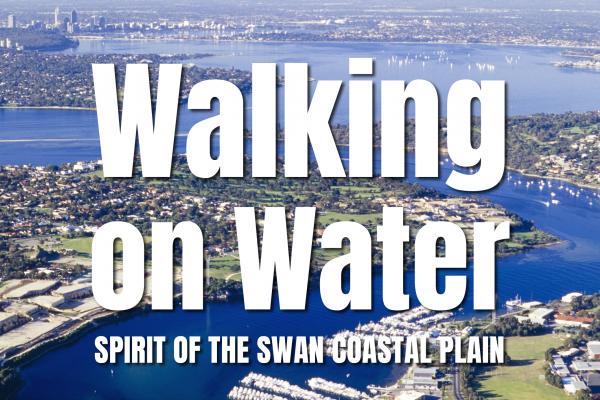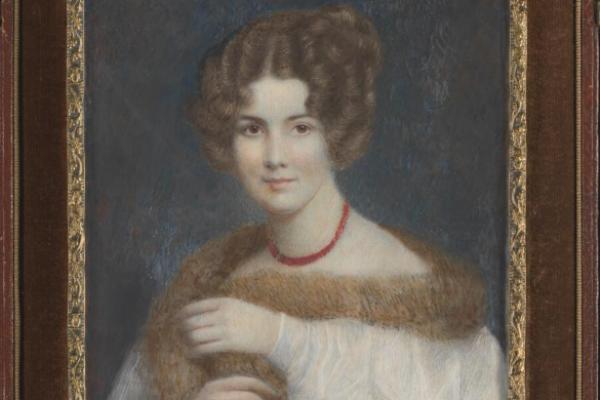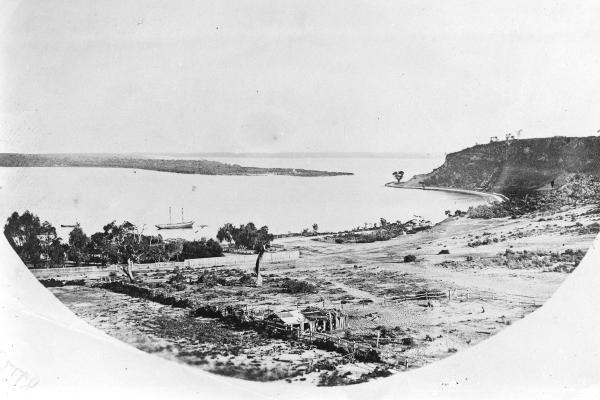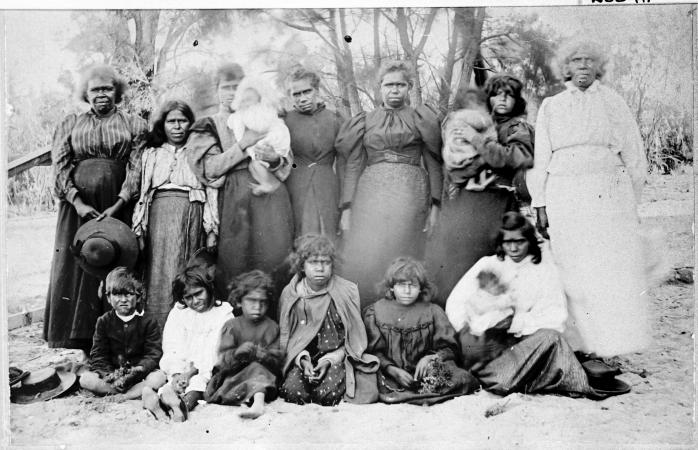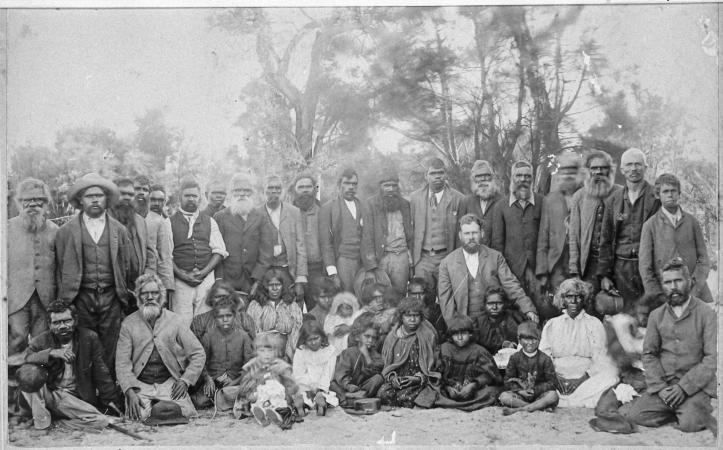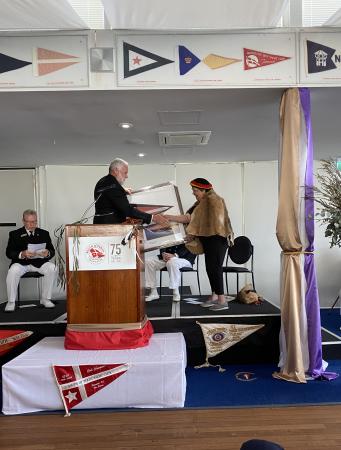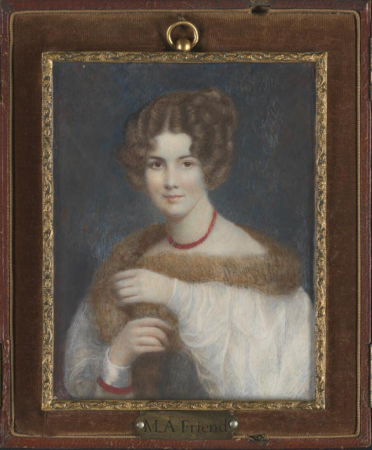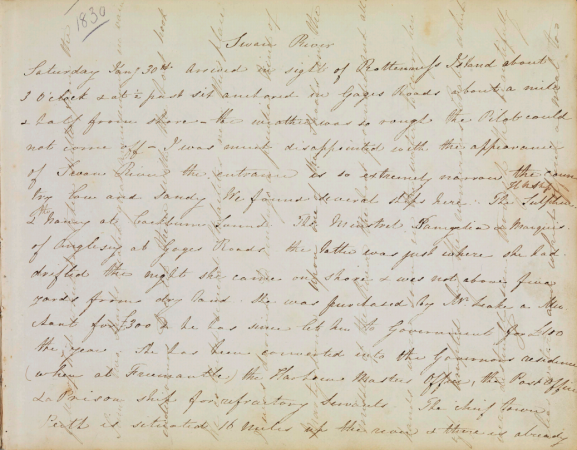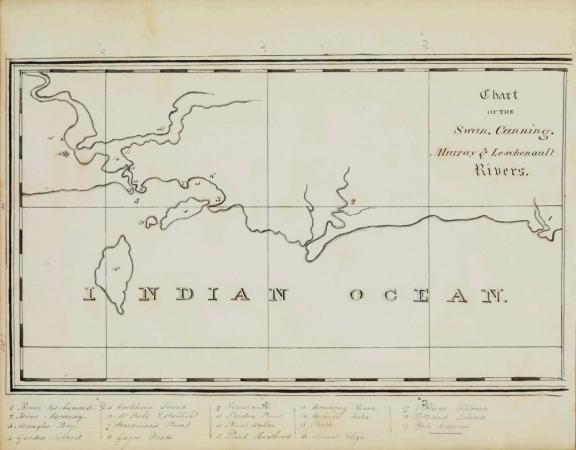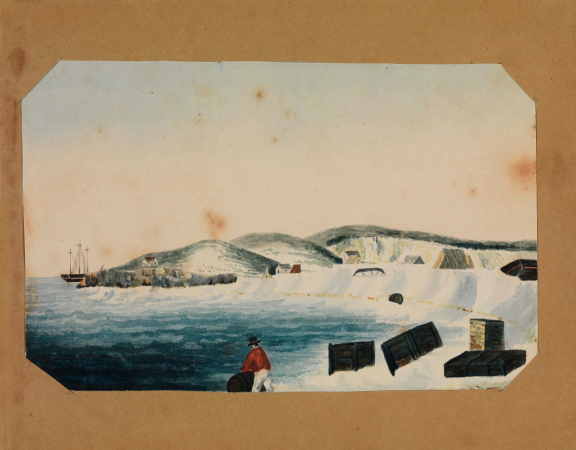Welcome to Rare Stories from the West – a State Library of Western Australia podcast series. Through these podcasts we hope to unearth tales of Western Australia’s past and present. On the Frontline is the second of three podcasts produced by Gina Pickering.
On the Frontline reveals the stories of two women who are significant voices in the story of the Swan River and its people. Mary Ann Friend and Fanny Balbuk each had very different experiences of colonisation. Until recently, their stories were little known.
Through her journal of a voyage to Hobart with an account of the settlement on the Swan River (1829-30), Mary Ann Friend provides a glimpse into the living conditions, the environment of the river, and encounters with Noongar people.
Fanny Balbuk, born around 1840, was a prominent Whadjuk Noongar woman who lived through the devastating impacts of colonisation. Whadjuk Noongar Elder, Marie Taylor, recounts the story of Balbuk’s life and her legacy.
This podcast explores how the State Library is helping to preserve their stories and why shining a light on the women’s stories of the Swan River Colony is essential today.
Podcast created by Gina Pickering - Latitude Creative Services and commissioned by the State Library of Western Australia.
You can view a digital copy of Mary Ann Friends journal or read a transcript on the State Library Catalogue. You can also watch a short documentary, from the University of Notre Dame, about the background, content, acquisition and preservation of her illustrated journal.
Transcript
Gina Pickering: Hi... My name is Gina Pickering. I’ve been telling stories about Western Australia since the 1980s. Over the last 20 years, these yarns have focused on the exceptional cultural aspects of the South West of the State/ Noongar Country.
In this podcast series, I’ll explore three surprising stories through the voices of Aboriginal Elders, artists, curators and historians and how the State Library of Western Australia is responding to the cultural demands of change in our time.
2021 has delivered some unexpected and shocking stories.
Revelations over the treatment of women and in the highest offices of the land have caused public outrage. Women took to the streets in every capital city.
Brittany Higgins was heard; Australian of the year Grace Tame was heard.
Cracks appeared in the national narrative and new disturbing truths emerged.
It’s not the first time women have defined the political landscape.
When colonisation swept into the Swan River Colony... the women were on the front line.
Sue Broomhall: The difference in the experience between the invader settlers who arrived from Britain and the experiences of the Aboriginal people who were already living here are fundamentally different. These women come from very different places and context, and have very different experiences about how they can live in the colony, live the lives they want to live, and conduct the activities they would like to live in this region.
I’m Sue Broomhall
[coastal sound]
Kate Gregory: We're in the preservation lab of the State Library, and //There's always interesting work going on here and lots of different equipment, lots of different types of paper, Japanese tissue paper, lots of different brushes, lots of conservation gear that our wonderful conservators use to make sure that our collection materials stays safe, for many hundreds of years.
My name is Kate Gregory, and I am the Battye Historian at the State Library of Western Australia.
So it's very exciting always to see the wonderful Mary Ann Friend journal.
And here it is. So this beautiful, leather-bound, quite hefty book with kind of gold embossed edges of the pages. And opening it up, there's some beautiful marble paper in the kind of front of it. And then pretty quickly we get into the writing of Mary Ann Friend. She was so neat. Her writing is so perfect, really, it's quite legible.
This is the voyage that left Portsmouth on August the 14th, 1829. And she starts her account, this is her travel account. Her husband, of course, was Matthew Curling Friend, the Captain of the Wanstead. And they're onboard the ship, the Wanstead on voyage to the Swan River Colony. And so we've got these wonderful pages day by day accounts of what she was seeing, the places that they were going, the people on board. It's quite a beautiful account, really. And it's obviously a female perspective, which is always really interesting.
[Voice over Actor Mary Ann Friend]
Sunday 31st.
It is very true the country is beautifully undulating and thinly wooded, but alas the soil is nothing but sand.
I was much disappointed with the appearance of the Swan River, the entrance is extremely narrow, the country low and sandy.
The chief town is situated 16 miles up the river and there is already a passage-boat plying from it to the mouth of the river. You can otherwise hire boats but the charges are enormous – for one trip to a ship and back with luggage they charge 4 pounds four shillings.
[River sound]
Kate Gregory: It's just a beautiful document. And I think, not only was she a wonderful writer and sort of diarist, she was also a fabulous artist. She has produced some wonderful watercolors, watercolor paintings. Yeah. This is one of the very earliest views that we have of Bathers Beach in Fremantle.
[Waves breaking/seagull sound]
Sue Broomhall: The women that we're talking about here, women such as Mary Ann Friend, Jane Currie, and Jane King, all of whom arrive in the colony in the first 10 years or so. These women are well educated, middle class women. They are all connected to the colonial settler elite that is found in the Swan River Colony.
I’m Professor Susan Broomhall, Historian with the Australian Catholic University.
They show us something more of the lived experience of tent life, a more disruptive, a more flexible, and perhaps less organized idea of what life was like than the colonial records of maps and plotted charts that give a sense of order that perhaps wasn't the reality on the ground.
Kate Gregory: They’re very rich sources of information these images you can get a lot of information about the topography of the place, the nature of the dwellings that they were living in. And then she describes it as well.
[Voice over Actor Mary Ann Friend]
Saturday January 30th
The town of Fremantle strongly resembles a country Fair and has a pretty appearance, the pretty white tents looking much like booths – at present there are not above five or six houses.
It is situated at the entrance to the Swan. The bar has never more than four feet of water over it, and at times is impassable; every morning this a strong land breeze and at evening a sea breeze, at which time is it impossible to go in the opposite direction. Mary Anne Friend
Kate Gregory: So really significant materials like the Freycinet Collection and the Mary Ann Friend Diary are very hard to get hold of. They're very rare for a start. They're of world significance, and they come up often through auction, which can be a very challenging process to work your way through.
I think the thing about Mary Ann Friend was that her view of the Swan River colony really shattered the utopian kind of view that was being presented in the papers in London and in the UK. Her view was suddenly the realistic sandy shores, the desperate conditions that people were living in, the strangeness of the environment, the encounters with Nyungar people. It's a really important document for those eyewitness accounts.
[birds sounds]
Sue Broomhall: So, we can contrast the experience of women like Mary Ann Friend, Jane Currie, and Jane King, with that of Fanny Balbuk, who was a very prominent Whadjuk Noongar woman, who lived in Perth, was born around 1840, just as the colony is really being established. So, in some ways, her entire life experience, she lives for 67 years, is mapping the colonial history of the region, and progressive acts of dispossession of Aboriginal land, and a denial of Aboriginal culture. So, she is living through a period in which Aboriginal people in the region are becoming increasingly powerless. And, she is a very prominent figure in trying to maintain her cultural practices on this landscape, which is being increasingly marked by colonial signs and symbols, including new streets, new landscapes, new environments, and new rules that govern how she can live in this environment. So, it's a very strikingly different experience of the same time period as the European women who are coming out as settlers.
Marie Taylor: For me, Fanny Balbuk used to be a picture in a book. I used to read about her and think oh yeah, she's just someone that Daisy Bates wrote about in her book.
My name is Marie Taylor, and I am a Whadjuk Ballardong Noongar elder.
And then I was invited to assist with looking at her history and turning it into a book and it made me realize that here is a lady who I can stand up and show my respect to, because this woman in the past, she stood up and she confronted people over her land, over her home, over the sites that were being washed away and burnt away and covered up and she would show her anger.
[birds wetlands sounds]
Marie Taylor: And I think that when we looked at her on the whole, we saw this young woman as she would have been when the non-Aboriginal people came on boats to her country and started to take over the land. It would have been a real shock for her because she was so used to walking and running through the bush and knowing where she had to go. And the thing that I want to highlight about her was her knowledge of her Aboriginal culture, traditions, her way of life, how they did things.
We're looking at somebody who has left her mark on the country.
[birds wetlands sounds]
Kate Gregory: The view of Fanny Balbuk and Mary Ann Friend as really significant early women in the landscape of the Swan River colony, Mary Ann Friend much earlier than Fanny Balbuk. But the view of these women is a rare one. It's often that the sort of male perspectives on the society and culture are more prominent in collections often. So to be able to kind of collect the view of women is really, really important.
Marie Taylor: A picture paints a thousand words. And I think when you walk into the library and you see this very strong Aboriginal woman looking at you, she had a way of looking that caught your attention.
Kate Gregory: The State Library has some wonderful images on display in the ground floor, just at the lifts, where people kind of enter the state library building to go up to the first, second or third floor in the Battye Library. And these images are pictures of a group of Aboriginal Nyungar women, , taken at Perth Zoo in about 1903, and included in the group of women is a really significant Fanny Balbuk, who was a very powerful, strong Nyungar woman, who really asserted her rights, I suppose, to property and land at the point in which there were more and more houses being built. // And we came across this image in our collection and thought that it would be a really powerful kind of statement for people coming into the building to kind of see this wonderful portrait.
Marie Taylor: ... it makes you think that, hey, this used to be swamp land and it's been filled in. This is where Fanny used to hunt and gather, and she would walk and she would practice her ceremonies and here she is today, sitting in this big building, watching and ensuring that the Aboriginal story here on Noongar country is never forgotten.
[Voice over: Gina]
Records about Fanny Balbuk are not centralized. The State Library of Western Australia is not the only cultural institution to have details relating to Fanny Balbuk’s life. The State Records Office holds court documents featuring her name and her original mark – an “X”, at Royal Perth Hospital, where she died, Fanny Balbuk’s name is listed amongst the admissions. And at the South Australian Library, Fanny Balbuk extensively informs Daisy Bate’s interviews and records. And perhaps the most extraordinary of all... a gut wrenching letter to her son Joe Donnelly--- written during her final years at Maamba Welshpool Native Reserve on the outskirts of Perth and held by National Library of Australia. Scribed by Daisy Bates on Balbuk’s behalf. Read by Elder and extended family member Marie Taylor.
[music]
Marie Taylor: Balbuk’s letter to her son, half-caste, Joe Donnelly: "Dear son. I'm glad to know that you got my letter at last and to know you are alive and well. When will you come down to see me? I hope you will soon come while I am alive.
"It won't be any good bringing me any money when I've gone to Koronup. So the sooner you come to town or send your mother some money, the better.
All our people are dead. Jimmy Shaw and Billy Shaw, your two uncles are the last that have died.
Old Joobaitch is alive and well, and lives close to me at the government reserve. Jimmy Shaw's daughter married Henry [Getcham 00:01:32], your cousin, and they have three children."
"Tommy Jenkins has married Igliget, Old Johnny Carroll 's daughter. Old Johnny Carroll is dead. Johnny Blurton has married and has got 10 children. What do you think of that? ........
I think for Joe and Fanny, they would have experienced some really traumatic times when he would have opened his mother's letter and read all of that information. The letter is a very powerful letter of a person's story at a certain time in their life.
Now I think I've given you all the news. I'm glad you got my letter and hope this will reach you too, and that it won't take you long to send me down some money. You won't be able to send me some for Christmas, I suppose. However, I'm sure you won't forget your old mother and will send me something as often as you can. With much love to you, my poor son, and goodbye for the present." Your affectionate mother, Fanny Balbuk."
It really touched me not only from a physical experience, but also a very spiritual experience.
And I think that when you read a letter like that, she proudly acknowledges that he's from a white man. So back then she wasn't ashamed of it. In some places when Aboriginals and non-Aboriginals got married that they were treated with disrespect and that was sad when you saw that.
Gina: There are plans for a Fanny Balbuk Yooreel Statue at Government House. In 2021 Fanny Balbuk was inducted into the WA Women’s Hall of Fame on international Women’s day... and plans are underway for an augmented reality as writer director Kelli Cross explains.
Kelli Cross: Yeah, so together with our little team with Pink Pepper & Periscope, them guys there, we are putting together a little project about Fanny. And it's going to be an augmented reality project, so it's really bringing a new futuristic perspective to an ancient kind of woman story. So we're delving into what it was like for her watching Perth change before her eyes when it was first settled by the Ghost Mob, that we are now calling the Ghost Mob. So obviously that's the English mob that came here and decided to live here. //
And so we're just hoping to introduce a new audience to a very important woman to the Noongar people here, especially in Perth because Perth City was her country, and it was where she was born and raised and where she would have grabbed her food to eat. That was her supermarket was where the Perth train station is now. So we're learning how Perth was for the Noongar people, the Whadjuk people back then. And hopefully we get to teach a lot of people about a very important story.
Kate Gregory: There's been much greater attention to the significance of Fanny Balbuk in recent years. And I think that's, it's kind of part of revisionist history. It's largely people really discovering the story of Fanny Balbuk and recognizing, finding that there are these records that are evidence of her life and the sort of fragments and snapshots that helped to create a picture of who she was as a person.
Kelli Cross: So a lot of people know about Yagan, but they don't know about his niece, which was Fanny. And the way she resisted to these people coming in and taking over her country basically. She did it in a way that was cheeky and probably troublemaking for the people that was trying to live here, I guess. But she always knew where she was coming from and why. And she could see it all disappearing before her eyes, this country that she grew up on. So I think it's very important that we understand whose country we are on right now.
my name is Kelli Cross. I'm a Ballardong Noongar, Malgana, Yamatji and Wedjula woman from Perth and I'm a writer and director.
Marie Taylor: This was Fanny's country. And she was a Bridiya and I think that's the thing that I would like to see come out of her hidden story is the fact that she was a warrior woman for her Nyungar people.
Kate Gregory: So the State Library does really prioritize collecting Aboriginal materials. We work with communities around the state and we want to make sure that communities can feel that the State Library is a place where their materials can be protected and preserved for the long term. So it's really relationship based. // But really what the State Library is very actively engaged in more is the digital return of collections to communities. // rather than necessarily collecting and capturing their history while that is important, it's also very important to make sure that communities know about the collections that we hold that relate to their own history.
You may also be interested in...
